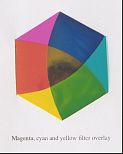|
To
better understand why a particular surface or pigment
reflects a certain colour, look carefully at the
effect of oil on water, the surface of a CD record,
or a butterfly's wing. It is the number of scales
on the wing, or molecules in the case of pigment,
in any given area, that determine the frequency
bands of light that are reflected and/or absorbed.
In this regard, art and science may have much in
common, especially when manipulating new technologies
and materials. There are more chemicals now available
for application on the contemporary palette, than
might be found in an average chemistry laboratory,
and there is clear and substantial empirical evidence,
to support recent theories of colour, in practice,
not available to the great Masters. |
|

CLICK HERE
for the animation |